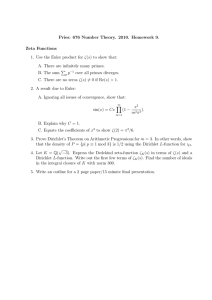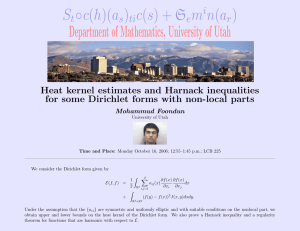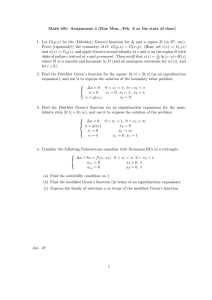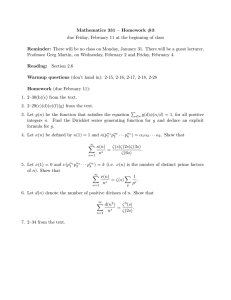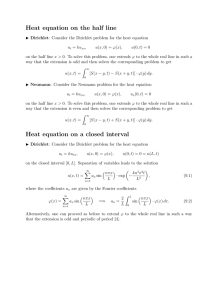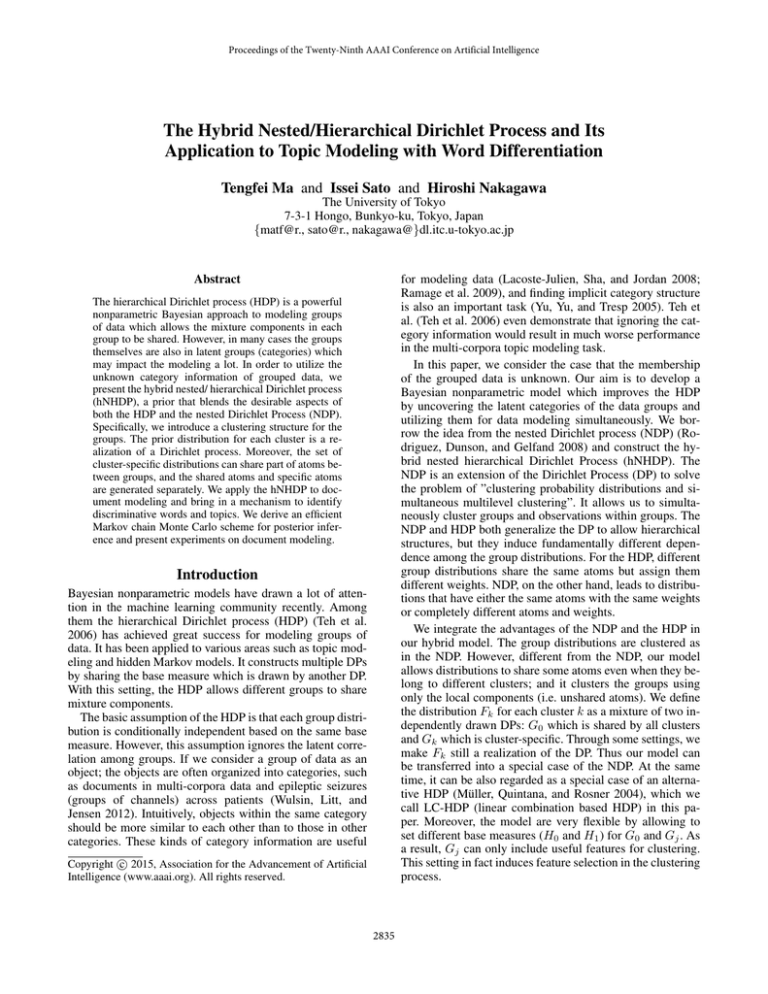
Proceedings of the Twenty-Ninth AAAI Conference on Artificial Intelligence
The Hybrid Nested/Hierarchical Dirichlet Process and Its
Application to Topic Modeling with Word Differentiation
Tengfei Ma and Issei Sato and Hiroshi Nakagawa
The University of Tokyo
7-3-1 Hongo, Bunkyo-ku, Tokyo, Japan
{matf@r., sato@r., nakagawa@}dl.itc.u-tokyo.ac.jp
Abstract
for modeling data (Lacoste-Julien, Sha, and Jordan 2008;
Ramage et al. 2009), and finding implicit category structure
is also an important task (Yu, Yu, and Tresp 2005). Teh et
al. (Teh et al. 2006) even demonstrate that ignoring the category information would result in much worse performance
in the multi-corpora topic modeling task.
In this paper, we consider the case that the membership
of the grouped data is unknown. Our aim is to develop a
Bayesian nonparametric model which improves the HDP
by uncovering the latent categories of the data groups and
utilizing them for data modeling simultaneously. We borrow the idea from the nested Dirichlet process (NDP) (Rodriguez, Dunson, and Gelfand 2008) and construct the hybrid nested hierarchical Dirichlet Process (hNHDP). The
NDP is an extension of the Dirichlet Process (DP) to solve
the problem of ”clustering probability distributions and simultaneous multilevel clustering”. It allows us to simultaneously cluster groups and observations within groups. The
NDP and HDP both generalize the DP to allow hierarchical
structures, but they induce fundamentally different dependence among the group distributions. For the HDP, different
group distributions share the same atoms but assign them
different weights. NDP, on the other hand, leads to distributions that have either the same atoms with the same weights
or completely different atoms and weights.
We integrate the advantages of the NDP and the HDP in
our hybrid model. The group distributions are clustered as
in the NDP. However, different from the NDP, our model
allows distributions to share some atoms even when they belong to different clusters; and it clusters the groups using
only the local components (i.e. unshared atoms). We define
the distribution Fk for each cluster k as a mixture of two independently drawn DPs: G0 which is shared by all clusters
and Gk which is cluster-specific. Through some settings, we
make Fk still a realization of the DP. Thus our model can
be transferred into a special case of the NDP. At the same
time, it can be also regarded as a special case of an alternative HDP (Müller, Quintana, and Rosner 2004), which we
call LC-HDP (linear combination based HDP) in this paper. Moreover, the model are very flexible by allowing to
set different base measures (H0 and H1 ) for G0 and Gj . As
a result, Gj can only include useful features for clustering.
This setting in fact induces feature selection in the clustering
process.
The hierarchical Dirichlet process (HDP) is a powerful
nonparametric Bayesian approach to modeling groups
of data which allows the mixture components in each
group to be shared. However, in many cases the groups
themselves are also in latent groups (categories) which
may impact the modeling a lot. In order to utilize the
unknown category information of grouped data, we
present the hybrid nested/ hierarchical Dirichlet process
(hNHDP), a prior that blends the desirable aspects of
both the HDP and the nested Dirichlet Process (NDP).
Specifically, we introduce a clustering structure for the
groups. The prior distribution for each cluster is a realization of a Dirichlet process. Moreover, the set of
cluster-specific distributions can share part of atoms between groups, and the shared atoms and specific atoms
are generated separately. We apply the hNHDP to document modeling and bring in a mechanism to identify
discriminative words and topics. We derive an efficient
Markov chain Monte Carlo scheme for posterior inference and present experiments on document modeling.
Introduction
Bayesian nonparametric models have drawn a lot of attention in the machine learning community recently. Among
them the hierarchical Dirichlet process (HDP) (Teh et al.
2006) has achieved great success for modeling groups of
data. It has been applied to various areas such as topic modeling and hidden Markov models. It constructs multiple DPs
by sharing the base measure which is drawn by another DP.
With this setting, the HDP allows different groups to share
mixture components.
The basic assumption of the HDP is that each group distribution is conditionally independent based on the same base
measure. However, this assumption ignores the latent correlation among groups. If we consider a group of data as an
object; the objects are often organized into categories, such
as documents in multi-corpora data and epileptic seizures
(groups of channels) across patients (Wulsin, Litt, and
Jensen 2012). Intuitively, objects within the same category
should be more similar to each other than to those in other
categories. These kinds of category information are useful
c 2015, Association for the Advancement of Artificial
Copyright Intelligence (www.aaai.org). All rights reserved.
2835
We then apply the hNHDP to the problem of topic modeling, which is a suitable case for illustrating its power. Our
model assumes documents to be mixtures of topics and assigns documents into latent categories. It discriminates between global topics and local topics and automatically identifies local words for local topics. The local topics and local
words could help explain the data structure as in the section
of experiments. In summary, the contribution of this work
includes:
Dirichlet process (LC-HDP). They considered a model in
which a coupled set of random measures Fj is defined as
Fj = G0 + (1 − )Gj ,
Gj ∼ DP(γ, H) for j = 0, 1, ...J.
where 0 ≤ ≤ 1 defines weights of the linear combination. This model provides an alternative approach to sharing
atoms, in which the shared atoms are given the same stickbreaking weights in each of the groups. Its has an attractive characteristic that it can discriminate local components,
which are useful for clustering.
• improving the HDP (as well as LC-HDP) by taking advantage of the latent category information of grouped
data.
The Nested Dirichlet Process
• improving the NDP by sharing mixture components
among all groups and discriminating local components.
The NDP (Rodriguez, Dunson, and Gelfand 2008) is motivated by simultaneously clustering groups and observations within groups. It induces multi-level clustering, while
the HDP can cluster only observations. In the NDP model,
the groups are clustered by their entire distribution. Consider a set of distributions {Gj }, each for one group. If
{Gj } ∼ nDP(α, γ, H), it means that for each group j,
Gj ∼ Q with Q ≡ DP(αDP(γH)). This implies that we
can first define a collection of DPs
• developing a topic model that organize documents into
latent categories by topic distributions and identifies
category-specific words and topics for data analysis.
Background
The Hierarchical Dirichlet Process
The HDP (Teh et al. 2006) is a Bayesian nonparametric prior
for modeling groups of data. It ensures that sets of groupspecific DPs share the atoms. Suppose that we have observations organized into groups. Let xji denote the ith observation in group j. All the observations are assumed to be exchangeable both within each group and across groups, and
each observation is assumed to be independently drawn from
a mixture model. Let F (θji ) denote the distribution of xji
with the parameter θji , which is drawn from a group-specific
prior distribution Gj . For each group j, the Gj is drawn independently from a DP, DP (α0 , G0 ). To share the atoms
between groups, the HDP model forces G0 to be discrete by
defining G0 itself as a draw from another DP, DP (γ, H).
The generative process for HDP is represented as:
G0
Gj
θji
xji
∼
∼
∼
∼
DP(γ, H),
DP(α0 , G0 ) for each j,
Gj for each j and i,
F (θji ) for each j and i.
(2)
G∗k ≡
∞
X
∗
∞
∗ with θ
wlk δθlk
lk ∼ H, (wlk )l=1 ∼ GEM(γ)
l=1
and then draw the group specific distributions Gj from the
following mixture
Gj ∼ Q ≡
∞
X
πk∗ δG∗k with (πk )∞
k=1 ∼ GEM(α)
k=1
The process ensures Gj in different groups can select the
same G∗k , leading to clustering of groups.
Although the NDP can also borrow information across
groups, groups belonging to different clusters cannot share
any atoms. For the NDP, the different distributions have either the same atoms with the same weights or completely
different atoms and weights. This makes it different from
the HDP.
(1)
The Hybrid Nested/Hierarchical Dirichlet
Process
Using the stick-breaking construction
P∞ of Dirichlet processes,
we can express G0 as G0 = k=1 βk δφk , where δφk is a
probability measure concentrated at the atom φk . The atoms
are drawn from the base measure H independently, and the
probability measure for the weights β ∼ GEM(γ)1 are mutually independent. Because G0 has support at the points
{φk }, each Gj necessarily has support
at these points as
P∞
well; and can thus be written as Gj = k=1 πjk δφk , where
the weights πj = (πjk )∞
k=1 ∼ DP(α0 , β).
We propose the hybrid nested/hierarchical Dirichlet process
(hNHDP) mixture model for groups of data. Our motivation is to improve the HDP by uncovering the latent categories of the groups. At the same time, we want to remain
the properties of HDP. Following the setting of HDP, assume
that we have M groups of data. Each group is denoted as
xj = xj1 , ..., xjNj , where {xji } are observations and Nj
is the number of observations in group j. Each xji is associated with a distribution p(θji ) with parameter θji . For
example, in topic modeling the distribution p is a multinomial distribution. We now describe the generative process of
observations using the hNHDP model.
As in the NDP, we first consider the set of distributions
{Fk } for different clusters. For each cluster (latent category)
k, we model Fk as a combination of two components, G0
LC-HDP
Motivated by a similar problem to that of the HDP(Teh et al.
2006), Müller et. al. (2004) developed another hierarchical
1
Here GEM stands for Griffiths, Engen, and McCloskey(2002).
Qk−1
We say β ∼ GEM(γ) if we have βk = βk0 k=1 (1 − βk0 ) for
k = 1, ..., ∞, where βk0 ∼ Beta(1, γ).
2836
Model Properties
The hNHDP has some interesting properties:
• (1) Fk is still a sample from a DP.
• (2) Fj0 can share atoms that are generated from G0 .
In (Lin, Grimson, and Fisher III 2010), the authors proposed
a new construction of DPs by three operations based on existing ones. This construction is also used to derive a coupled mixture model for groups of data (Lin and Fisher 2012).
Here we cite one of the operations: the superposition.
Superposition 1 Let Dk ∼ DP(αk Bk ) for k = 1, ..., K be
independent DPs and (c1 , ..., ck ) ∼ Dir(α1 , ..., αk ). Then
the stochastic convex combination of these DPs remains a
DP,
c1 D1 + · · · + ck Dk ∼ DP(α1 B1 + · · · + αk Bk ).
From the set of equations in (3), we can infer that clusterspecific distribution Fk in the hNHDP model is still a realization of DP.
Fk ∼ DP(αH0 + βH1 ).
With this form, the hNHDP can be transferred into a special
NDP. However, the generative process of (5) is not the same
as that of (3) because G0 is only sampled once in (3). If
we directly use form (5) for each cluster, H0 will generate
different atoms for each cluster.
Now we consider the relationship between the hNHDP
and the LC-HDP. We ignore the clustering structure of the
hNHDP, and focus on only the group-specific distributions
{Fj0 }. For each group j, Fj0 can be written as k G0 + (1 −
k )G0j where k = cj is the cluster label and G0j = Gk . If
k is same for all k,the hNHDP degenerates into a special
LC-HDP. It also indicates that Fj0 can share atoms generated
from a global component G0 .
Figure 1: Graphical model representation of hNHDP.
and Gk . This setting is similar to that for the LC-HDP, but
we impose some additional restrictions on the parameters.
The combination weight k is changed for each cluster, and
the two components are drawn from DPs with different base
measures.
G0
Gk
k
Fk
∼
∼
∼
=
DP(α, H0 ),
DP(β, H1 ) for each k,
Beta(α, β) for each k,
k G0 + (1 − k )Gk for each k.
(3)
Application to Topic Modeling
After getting the cluster-specific distributions, we assign
the group distributions Fj0 to the set {Fk }. This hierarchy is
the same as that of the NDP.
Fj0 ∼
∞
X
ωk δFk
(5)
Motivation
Topic modeling is always an important application of the
Bayesian nonparametric models. It is also suitable to illustrate the motivation and the power of the hNHDP, for category information is very useful for topic modeling. For
example, the discriminative LDA(Lacoste-Julien, Sha, and
Jordan 2008) and the labeled LDA(Ramage et al. 2009),
which utilized category (or label) information of documents,
had better predictive performance than the general unsupervised LDA (latent Dirichlet allocation (Blei, Ng, and Jordan
2003)). Now consider the HDP for topic modeling. In the
case of modeling documents in multiple corpora (each corpus is a category), Teh et al. (Teh et al. 2006) demonstrated
that a 2-level HDP that treats documents from different corpora in the same way performs much worse than a 3-level
HDP that considers the category information of documents
. All these studies proved the advantage of discriminating
documents from different categories in text modeling. This
stimulated us to take consideration of the document structure
and to utilize it.
In practice , however, we often do not know category information in the topic modeling task. In this case, we could
(4)
k=1
where ω = {ωk } ∼ GEM(γ). This is equal to selecting a
cluster label k for a group and then assigning Fk to the group
as its distribution. Then we generate observations using the
following process.
• For each object xj ,
– Draw a cluster label cj ∼ ω;
– For each observation xji
∗ θji ∼ Fcj ;
∗ xji ∼ p(xji |θji ).
A graphical model representation is shown in Figure 1.We
can also define the hNHDP mixture model in another way.
For each group, the observations
R are independently drawn
from the distribution Pj (·) = p(·|θ)d(Fj0 (θ)) where Fj0 is
drawn from the hNHDP prior as above and xji ∼ Pj for
each i in group j.
2837
The G0 and G1 are also approximated by the DMA.
apply the hNHDP model to topic modeling to discover both
latent categories and latent topics. We assume that word is
an observation and that a document is a group. We generate
the parameter distribution Fj0 for each document j using the
generative process in Section , where the distribution p(θji )
is set as a multinomial distribution with parameter θji . The
base measures H0 and H1 are set as Dirichlet distributions
over words.
G0 =
wl0 δθl0
l=1
Gk =
L
X
wlk δθlk
(7)
l=1
where (w10 , ..., wL0 )
∼
Dir(α/L, ...α/L) and
(w1k , ..., wLk ) ∼ Dir(β/L, ...β/L). If we set K and
L large, the DMA can give a good approximation in our
model.
hNHDP for Topic Modeling with Word
Differentiation
Feature selection is an critical process in clustering analysis,.
By selecting a subset of efficient features, feature selection
can improve the text clustering efficiency and performance
(Liu et al. 2003). Feature selection has already been successfully used in the Dirichlet mixture models for clustering
(Kim, Tadesse, and Vannucci 2006; Yu, Huang, and Wang
2010; Wang and Blei 2009). So we also want to integrate
feature selection into our model to reduce the dimension of
topics and avoid noisy words in clustering. Our solution is
word differentiation as follows.
Assuming that the size of the vocabulary is V , we bring
in a binary vector q1 = (q11 , ..., qV1 ) to select discriminative words and separate the vocabulary into two disjoint sets.
If qv1 = 1, the word v is regarded as discriminative and
included only in local topics. Otherwise, v is regarded as
global and included only in global topics. In this way we get
two disjoint base measures, H0 and H1 , for the hNHDP.
Inference
We use the Gibbs sampling method to infer the posterior of
parameters. The inference proceeds through the following
steps.
Sampling the cluster indicators cj .
As we use the DMA approximation for ω in (6), the probability of cluster assignments conditioned on other variables
can be calculated as
P (cj = k|c−j , ...) ∝
L
YX
mk − 1 + γ/K
∗
M −1+γ
(k wl0 P (xji |θl0 ) + (1 − k )wlk P (xji |θlk )) ,
xji l=1
v
where p(xji |θlk ) = θlk
, v = xji . M is the number of documents, and mk is the number of documents assigned to cluster k.
Since the global words and local words are disjoint, we
can re-write the upper equation as
• For each word v
– qv0 ∼ Bernoulli(π).
– qv1 = 1 − qv0 .
• H0 = Dir(ηq0 );
• H1 = Dir(ηq1 ).
P (cj = k|c−j , ...) ∝
Here, q0 and q1 are binary vectors q0 = (q10 , ..., qV0 )
and q1 = (q11 , ..., qV1 ). For the parameter π, we set π ∼
Beta(α, β) to conform with the hyperparameters of k . In
practice, we may not require that the qv0 is uncertain if we
already know the feature words; and it is also possible that
qv1 6= 1 − qv0 . However, these cases are not discussed in this
paper.
L
Y X
mk − 1 + γ/K
∗
M −1+γ
(k wl0 P (xji |θl0 )) ∗
xji ∈A0 l=1
L
Y X
((1 − k )wlk P (xji |θlk )) ,
xji ∈A1 l=1
where A0 := {v|qv0 = 1} and A1 := {v|qv1 = 1} are the sets
of global words and local words.
Sampling topic assignment zji for each word xji .
Finite Approximation
Samplers for the NDP based on Pólya Urns are in general infeasible(Rodriguez, Dunson, and Gelfand 2008). Our
hNHDP encounters the similar problem, so here we use a
finite approximation. In Bayesian statistics, the Dirichletmultinomial allocation (DMA) has often been applied as
a finite approximation to the DP (Yu, Yu, and Tresp
2005; Yu, Huang, and Wang 2010). It takes the form
PN
GN =
l=1 πl δθl , where π = (π1 , ..., πN ) is an N dimensional vector distributed as a Dirichlet distribution
Dir(α/N, ...α/N ). In our inference step, we approximate
ω in (4) by a finite Dirichlet distribution
ω ∼ Dir(γ/K, ...γ/K).
L
X
P (zji = tlk |cj = k, ...) ∝ (1 − k ) ∗ wlk P (xji |θlk )
P (zji = tl0 |cj = k, ...) ∝ k ∗ wl0 P (xji |θl0 ),
(8)
where tlk and tl0 are topic indices.
Sampling the weights {wl0 } and {wlk } for G0 and G1 .
(w1k , ..., wLk ) ∼ Dir(β/L + n1k , ..., β/L + nLk )
(9)
(w10 , ..., wL0 ) ∼ Dir(α/L + n10 , ..., α/L + nL0 ), (10)
where nlk is the number of words assigned to topic tlk .
Sampling θlk and θl0
(θlk |...) ∼ Dir(ηq11 + n1lk , ..., ηqV1 + nVlk )
(6)
2838
(11)
(θl0 |...) ∼ Dir(ηq10 + n1l0 , ..., ηqV0 + nVl0 ),
Gamma(0.1, 1) and set η = 0.5 for H0 and H1 . The component numbers in DMA approximation are set as K = 100,
L = 30. The other parameters were α = β = 1. For each
training set, we ran 1000 iterations and treated the first 500
as burn-in. In the initialization step, we used a simple feature
selection method which ranks words by term variance quality (Dhillon, Kogan, and Nicholas 2004). We selected a random proportion of highest ranked words as discriminative
words, while the others were set as global words. This allowed us to accelerate the convergence in the sampling process.
The models used for comparison were the following:
(12)
nvlk
is the count when the word v assigned to topic lk.
Sampling k
(k |...) ∼ Beta(α +
L
X
nl0 , β +
l=1
L
X
nlk )
(13)
l=1
Sampling q. For the word selection variable q (including
q 0 and q 1 )2 , we use the Metropolis-Hastings algorithm. In
each step, we randomly select a word v and invert its qv
value. When q changes, the associated θ (i.e. the collection
of θlk and θl0 ) should also be changed. As it is difficult to
integrate out θ for the posterior distribution of q, we update q
with θ together. The new candidates q∗ and θ∗ are accepted
with probability
P (q0∗ , θ∗ |c, X, ...)P (q0 , θ|q0∗ , θ∗ )
min 1,
(14)
P (q0 , θ|c, X, ...)P (q0∗ , θ∗ |q0 , θ)
• HDP-LDA (Teh et al. 2006). We used the 2-level HDP
mixture model, which ignores the group information of
documents. Articles from different sections were not
treated differently. We followed the parameter setting
procedure given in (Teh et al. 2006). The concentration parameters for the two levels were given as: γ ∼
Gamma(5, 0.1), α ∼ Gamma(0.1, 0.1). The base measure of the bottom level was a symmetric Dirichlet distribution over all words with parameters of 0.5.
This is equal to
P (X|q0∗ , θ∗ , ...)P (qv0∗ )
min 1,
P (X|q0 , θ, , ...)P (qv0 )
(15)
• NDP. This model is based on the nested Dirichlet process.
In its settings, G0 did not exist and Fk = Gk . Since the
NDP model does not share topics between clusters, it does
not distinguish either local topics or local words.
where X is the collection of all the documents.
Sampling π
(π|...) ∼ Beta(α + N0 , β + N1 ).
(16)
• hNHDP-nosel. For this model, we used the same structure as for the proposed hNHDP model. The difference
was that here we set H0 = H1 ∼ Dir(η) . The base measures H0 and H1 were symmetric Dirichlet distributions
over all words. In other words, this model does not differentiate words between global and local, while it remains
to distinct global topics from local topics.
N0 and N1 are the numbers of unique words identified
as
P global and local ones respectively. Notice that N1 6=
l,k nl,k , because N1 counts each word only once.
Experiments
Document Modeling on Real Data
We evaluated all the models with the test-set perplexity, a
standard metric for document modeling.
P
log p(xd |Dtrain )
P
perplexity(Dtest ) = exp(− d∈Dtest
).
d∈Dtest Nd
We implemented the proposed hNHDP model on two realworld text datasets. The first one is the NIPS data, which is
used in (Teh et al. 2006)3 . This version of NIPS data collects
NIPS articles from 1988–1999 and unifies the section labels
in different years. It contains 13649 unique words and 1575
articles separated into nine sections: algorithms and architectures, applications, cognitive science, control and navigation, implementations, learning theory, neuroscience, signal processing, and vision sciences. The other dataset is ”6
conference abstracts (6conf)”, which contains abstracts from
six international conferences (IJCAI, SIGIR, ICML, KDD,
CVPR, and WWW) collected by (Deng et al. 2011). It has
11,456 documents and 4083 unique words. All words are
stemmed and stop words are removed.
We compared our model with other models on training
sets of various sizes as in (Lin and Fisher 2012). Each dataset
was separated into two disjoint sets, one for training and
the other for testing. We generated 6 pairs of training/testing
datasets for NIPS data and 5 pairs for 6conf data. For all the
experiments, we used the same setting of parameter settings
for our model. We gave the hyperparameter γ a vague value
Figures 2(a) and 2(b) compare the perplexities on the two
data sets. Our proposed model, hNHDP, achieved the best
perplexities (lower is better) in all runs. Especially, it exceeded HDP-LDA by a large amount.
In addition, with the same setting for topic-word distributions (a symmetric Dirichlet distribution over all words), the
hNHDP-nosel performed better than the NDP and HDP. The
former demonstrates the advantage of sharing global topics
and distinguishing local topics, while the latter indicates the
effectiveness of taking advantage of the clustering structure
of documents. We also noticed that the performance of the
hHNDP was obviously better than that of the hHNDP-nosel
only for some training sizes, while the two models got comparable results in other runs. This is reasonable because the
vocabulary size was so large that the tail words of each topic
may have contributed little. Thus, we may suppose that the
global words in local topics and the local words in global
topics contributed little to predictive performance, resulting
in a result similar to the hNHDP’s. Nevertheless, the hNHDP
2 1
q is dependent on q0 via the equation q1 = 1 − q0 , so we
only need to consider q0 here.
3
http://www.stats.ox.ac.uk/∼teh/research/data/nips0 12.mat
2839
(a) Results of document modeling on NIPS (b) Results of document modeling on 6conf (c) Comparison of hNHDP and hNHDPdata.
data.
knowncategory.
Figure 2: Perplexity Results on Real Data Sets
still achieved our aim by greatly reducing the model complexity without any performance decrease (in fact the performance increased a little). Its ability to extract local topics
and local words is an additional benefit.
At last, we also wanted to know how well the latent categories found by hNHDP improves document modeling. So
we developed another model, hNHDP-knowncategory,
which assumes that the category labels of documents
are known. It assigns real labels to documents in the
hNHDP model and does not change them during iterations. Comparing the two models (Figure 2(c)), we
found that the performance of hNHDP was comparable to
hNHDP-knowncategory on NIPS data, while on 6conf
data it was even better. These results indicate the efficiency
of hNHDP for document modeling.
Table 1: Some example topics extracted from 6conf data.
Each column is a topic; for each topic the top 12 words are
shown. The numbers in brackets are the typical cluster numbers of each conference shown in Figure 3.
Local Topics
Global Topics
CVPR(23) ICML(16) SIGIR(31)
task
imag
learn
retriev
model
algorithm queri
predict
experiment
recognit
problem
inform
object
method
model
work
describ
base
search
document
fast
track
reinforc
base
segment
gener
system
solut
requir
motion
optim
relev
specif
shape
base
languag
context
visual
model
term
detect
function
data
express
categor
estim
plan
effect
Clustering and Visualization
We then showed that hNHDP could find reasonable document structures and used them for visualization. We first
present the clustering results on 6conf data in Figure 3. Although the number of clusters inferred by our model is a
little bigger than the real one, each conference has its specific clusters, which we can easily differentiate in the figure.
Moreover, we could also find the connection between the
conferences in Figure 3. CVPR is separate from the others,
with only a little connection with ICML and IJCAI. ICML
and KDD have a large overlap, but ICML has an additional
cluster component. SIGIR and WWW also own the same
major clusters although the cluster densities may differ. IJCAI is a comprehensive conference, so it includes several
clusters shared by other conferences as well as a specific
cluster.
We then extracted the typical topics in each cluster and
matched them with corresponding conferences. The topics
are shown in Table 1. The global topics/words and the local topics/words are easily distinguished in the table. The
local topics conform to the features of different conferences.
From Figure 3 and Table 1, we can see that both the clusters and the topics can be well explained and that they reveal
the structure and features of the data. Although clustering is
just a by-product of the hNHDP, we still made some quantitative evaluation of clustering results and demonstrated that
hNHDP beat NDP. Limited to space, they are listed in supplemental materials. We also showed some simulated study
of the model there to explain the iteration process.
Conclusions and Future Work
We proposed an extension to the HDP model for modeling
groups of data by taking advantage of the latent category information of groups. The hNHDP model clusters the groups
and also allows the clusters to share mixture components.
The application of the hNHDP to topic modeling illustrates
the power of the new prior. We identify both local topics
and local words in the model and use them for clustering
documents. Experiments on document modeling with real
datasets proved the advantage of the hNHDP.
In addition to document modeling, the hNHDP can also
be used for other applications, such as multi-level clustering of patients and hospitals. Moreover, the global exponents can be replaced by some context information, leading to some context-based models. Important future work
includes enhancing the computation efficiency.
2840
tributions for split-and-merge transformations of an interval partition. Combinatorics, Probability and Computing
11(5):501–514.
Ramage, D.; Hall, D.; Nallapati, R.; and Manning, C. D.
2009. Labeled lda: A supervised topic model for credit attribution in multi-labeled corpora. In Proceedings of the
2009 Conference on Empirical Methods in Natural Language Processing, 248–256.
Rodriguez, A.; Dunson, D. B.; and Gelfand, A. E. 2008. The
nested dirichlet process. Journal of the American Statistical
Association 103(483).
Teh, Y. W.; Jordan, M. I.; Beal, M. J.; and Blei, D. M. 2006.
Hierarchical dirichlet processes. Journal of the american
statistical association 101(476).
Wang, C., and Blei, D. M. 2009. Decoupling sparsity and
smoothness in the discrete hierarchical dirichlet process. In
Advances in neural information processing systems, 1982–
1989.
Wulsin, D.; Litt, B.; and Jensen, S. T. 2012. A hierarchical
dirichlet process model with multiple levels of clustering for
human eeg seizure modeling. In Proceedings of the 29th
International Conference on Machine Learning (ICML-12),
57–64.
Yu, G.; Huang, R.; and Wang, Z. 2010. Document clustering
via dirichlet process mixture model with feature selection. In
Proceedings of the 16th ACM SIGKDD international conference on Knowledge discovery and data mining, 763–772.
Yu, K.; Yu, S.; and Tresp, V. 2005. Dirichlet enhanced latent
semantic analysis. In In Conference in Artificial Intelligence
and Statistics, 437–444.
Figure 3: Visualization of the clustering results on 6conf
data. The red lines indicate the real labels, while the blue
points indicate the clustering assignments.
References
Blei, D. M.; Ng, A. Y.; and Jordan, M. I. 2003. Latent
dirichlet allocation. the Journal of machine Learning research 3:993–1022.
Deng, H.; Han, J.; Zhao, B.; Yu, Y.; and Lin, C. X. 2011.
Probabilistic topic models with biased propagation on heterogeneous information networks. In Proceedings of the
17th ACM SIGKDD international conference on Knowledge
discovery and data mining, 1271–1279. ACM.
Dhillon, I.; Kogan, J.; and Nicholas, C. 2004. Feature selection and document clustering. In Survey of text mining.
Springer. 73–100.
Kim, S.; Tadesse, M. G.; and Vannucci, M. 2006. Variable
selection in clustering via dirichlet process mixture models.
Biometrika 93(4):877–893.
Lacoste-Julien, S.; Sha, F.; and Jordan, M. I. 2008. Disclda: Discriminative learning for dimensionality reduction
and classification. In Advances in neural information processing systems, 897–904.
Lin, D., and Fisher, J. 2012. Coupling nonparametric mixtures via latent dirichlet processes. In Advances in Neural
Information Processing Systems 25, 55–63.
Lin, D.; Grimson, E.; and Fisher III, J. W. 2010. Construction of dependent dirichlet processes based on poisson processes. Neural Information Processing Systems Foundation
(NIPS).
Liu, T.; Liu, S.; Chen, Z.; and Ma, W.-Y. 2003. An evaluation on feature selection for text clustering. In ICML, volume 3, 488–495.
Müller, P.; Quintana, F.; and Rosner, G. 2004. A method for
combining inference across related nonparametric bayesian
models. Journal of the Royal Statistical Society: Series B
(Statistical Methodology) 66(3):735–749.
Pitman, J. 2002. Poisson-dirichlet and gem invariant dis-
2841


